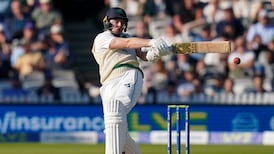Perhaps last weekend wasn't the place to start a major analysis of attendances, but the sight of Tipperary and Limerick lining out in the Gaelic Grounds to the tumult of 1,500 and the atmosphere of a mausoleum was dispiriting. Times are hard in both counties. The promise of Limerick's bountiful under-21 success further evaporates with each passing each year whereas Tipp's slide from All-Ireland euphoria to despair in the space of little over three seasons has been remorseless.
That two such important hurling counties are so downbeat is a reliable indicator of a troubled game.
Obviously there are troughs and peaks for every county but hurling's cast list is so restricted that it can ill afford established players to forget their lines.
Neither can it afford to be as haphazard about optimising the marketing opportunities of the National League. Leave aside Limerick - even Kilkenny and Galway scarcely improved on the Gaelic Grounds attendance.
Promotionally it would have been better not to go head-to-head with the rugby international. Maybe it would have been too awkward to organise at short notice (although the Six Nations schedule became available last year). Of the three most attractive fixtures, the above two moved forward the throw-in time but in the case of Limerick-Tipp this was purely to accommodate the television audience.
That was TG4's input as the station didn't want any more of a clash with Lansdowne Road than it could avoid. But the same principles could have applied for the Games Administration Committee, whose call it would have to have been given that the counties weren't pushing for re-scheduling.
But it's ironic in a season when broadcasters are treating the leagues to unprecedented coverage, that the GAA effectively reduced the audience by not reacting to the presence of such a major event on a league Sunday.
The GAC has to work with the counties and may have felt that orchestrating disruption by switching the fixtures forward a day would have caused bad feeling in a schedule, which already will feature quite a few Saturday programmes.
But moving the matches would have been a pro-active way of safeguarding the audience even if some improvisation with the Sigerson final would have been necessary. Two years ago GAC moved all fixtures from clashing with the corresponding rugby international and even if that day was a Grand Slam decider, last week's match was always going to be a stand-out fixture for Ireland.
Anyway the nuts and bolts are irrelevant. It's just not a great idea to clash with high-profile international matches involving Ireland and that could have been anticipated. In the past rugby hasn't been a major attraction even at international level. But recently that has changed whether because of the greater success of the national team or other factors and last autumn saw figures of 500,000 for the friendly against Argentina.
More startling are the initial figures that indicate Sunday's international bringing in an audience of around 750,000 - even more than last year's All-Ireland finals, which were themselves well up on 2003, and usually top the annual sports viewership figures.
Increasingly the television audience for sport is uniform: large audiences watch big events across the sporting spectrum. The point of this isn't that the GAA is slipping but rather that the wide-ranging interests of the viewership must be recognised if football and hurling are to maximise their audiences.
Attendances would also have benefited. The huge appetite of the public for intercounty activity is well demonstrated by the crowds that turn out for the football competitions in January, especially the O'Byrne Cup in Leinster but also the McKenna Cup in Ulster.
The National Hurling League opened with a good attendance at Kilkenny-Waterford but the structure of the NHL is almost hostile to the task of maximising interest. At present Division One comprises two sections and 12 counties, including four - Antrim, Down, Dublin and Laois - who (pace last year's Offaly meltdown and Laois's resilience) rarely win matches against the rest of the division. This makes a marketing disaster of the weekly programmes, which frequently involve just one competitive match per section.
Over three years ago the Competitions Work Group report featured in Appendix One a sample NHL schedule, which contained fixtures for a nine-team Division One: Cork, Waterford, Wexford, Clare, Galway, Offaly, Kilkenny, Limerick and Tipperary. This would have entailed a reversion to a sensibly sized top flight.
Eight years ago, the eight-team Division One in the first season of calendar-year scheduling proved very successful with decent, competitive matches a feature of every week's programme. Ever since, instead of building on the success of the format, the NHL has featured a two-section first division containing between 12 and 14 teams divided into groups of six or seven. In hurling terms it's been a disaster: unattractive to spectators and mostly useless to team managers, it was a feature that needed reform. The argument against putting it right in 2001 was that the league structure couldn't be changed until teams had an opportunity to make the cut. In other words, the bottom teams in Division One shouldn't be stripped of their status if they were unaware during the league that such a cull was coming.
Now far from being any closer, this reform is dead because the Tier One All-Ireland championship, is based on Division One counties.
Questionable as that may be in the summer, when the League trends are intensified, it's proving a promotional nightmare in the spring.










